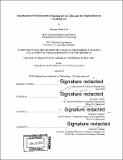| dc.contributor.advisor | Robert E. Cohen and Michael F. Rubner. | en_US |
| dc.contributor.author | Lim, Rosanna Marie | en_US |
| dc.contributor.other | Massachusetts Institute of Technology. Department of Chemical Engineering. | en_US |
| dc.date.accessioned | 2016-09-13T19:12:58Z | |
| dc.date.available | 2016-09-13T19:12:58Z | |
| dc.date.copyright | 2016 | en_US |
| dc.date.issued | 2016 | en_US |
| dc.identifier.uri | http://hdl.handle.net/1721.1/104211 | |
| dc.description | Thesis: Ph. D. in Chemical Engineering Practice, Massachusetts Institute of Technology, Department of Chemical Engineering, 2016. | en_US |
| dc.description | Cataloged from PDF version of thesis. | en_US |
| dc.description | Includes bibliographical references. | en_US |
| dc.description.abstract | The development of targeted drug delivery systems is of fundamental importance for the transport of highly toxic drugs to diseased cells. One way of achieving this is using biohybrid materials, which integrates synthetic components with cells in order to confer unique properties to existing biological systems. An example of this is the cell backpack, which consists of a circular, polymeric patch, microns in diameter and hundreds of nanometers thick, attached to the surface of a cell. Unlike passive delivery systems, cells have the ability to use signaling and trafficking to actively target a disease site. Cells carrying drug-loaded backpacks would thus be able to efficiently carry drugs to unhealthy cells. The cell backpack material itself is a polymeric patch consisting of stratified layers forming nanostructured compartments. In this thesis, the cell backpack is further developed to improve versatility and drug loading. First, a new, sacrificial thin film is developed to detach the cell backpacks from the substrates that they are fabricated on. This sacrificial multilayer, composed of bovine submaxillary mucin and jacalin lectin, is stable in a wide pH and ionic strength range and dissolves using a chemical stimulus. This mucin/lectin releasable region increases versatility by allowing more materials to be incorporated into the cell backpack, such as drug-containing liposomes. Echogenic liposomes containing doxorubicin were embedded into cell backpacks, and the ability of using these cell backpacks as a targeted, anti-cancer therapy was evaluated by studying the effects on mouse monocytes. Finally, thin films containing maleimide groups were developed for the cell backpacks to covalently attach these polymeric patches to cell surfaces. Former cell surface attachment techniques relied on cell-specific receptors, so covalent attachment would allow backpacks to attach to a greater variety of cells. The advancements investigated in this thesis work help to bring cell backpack technology one step closer to becoming a viable, therapeutic product. | en_US |
| dc.description.statementofresponsibility | by Rosanna Marie Lim. | en_US |
| dc.format.extent | 170 pages | en_US |
| dc.language.iso | eng | en_US |
| dc.publisher | Massachusetts Institute of Technology | en_US |
| dc.rights | M.I.T. theses are protected by copyright. They may be viewed from this source for any purpose, but reproduction or distribution in any format is prohibited without written permission. See provided URL for inquiries about permission. | en_US |
| dc.rights.uri | http://dspace.mit.edu/handle/1721.1/7582 | en_US |
| dc.subject | Chemical Engineering. | en_US |
| dc.title | Attachment of polyelectrolyte multilayers to cells and the implications on cell behavior | en_US |
| dc.type | Thesis | en_US |
| dc.description.degree | Ph. D. in Chemical Engineering Practice | en_US |
| dc.contributor.department | Massachusetts Institute of Technology. Department of Chemical Engineering | |
| dc.identifier.oclc | 958138931 | en_US |
